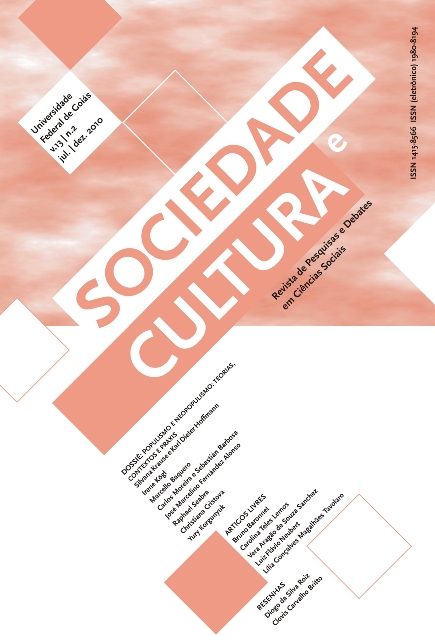Populist tactics and populist rhetoric in political parties of Post-Soviet Russia
DOI:
https://doi.org/10.5216/sec.v13i2.13427Palavras-chave:
Post-Soviet Russia, political parties, populismResumo
The article of Yu. Korguniuk (Russia) is devoted to various appearances of populism in tactics and rhetoric of political parties in post-Soviet Russia (since 1990). The author discusses these appearances in activities both of political parties which may be called populist without a shadow of doubt, and parties which use populist tactics and populist rhetoric but cannot be considered populist in the full sense of the word. To his opinion, populism in post-Soviet Russia has some features similar to Latin American populism and some which distinguish it from the latter. The common characteristics are charismatic leadership, political personalism, priority of leadership over institutions, adherence to national development concepts and anti-globalization movement. The difference lies in the interpretation of ‘anti-imperialism’: the Russian populism is anti-American and anti-Western but not anti-imperialist in general. Russian populists are, as a rule, extreme Russian imperialists and, to a certain degree, nationalists. The Russian populism also may be called statist and paternalistic: there is almost no difference between left (socialist) and right (nationalist and conservative) populisms in Russia. Besides, the author argues that many traditional ideologies – such as communism and nationalism – are, in fact, varieties of ‘state populism’ in today’s Russia. He concludes that populism have embraced the whole Russian political spectrum, including even those sectors which have always positioned themselves as anti-populist.Downloads
Não há dados estatísticos.
Downloads
Publicado
2011-03-02
Como Citar
KORGUNUYUK, Yuri. Populist tactics and populist rhetoric in political parties of Post-Soviet Russia. Sociedade e Cultura, Goiânia, v. 13, n. 2, p. 233–245, 2011. DOI: 10.5216/sec.v13i2.13427. Disponível em: https://revistas.ufg.br/fcs/article/view/13427. Acesso em: 26 dez. 2025.
Edição
Seção
Dossiê
Licença
Autores/as que publicam nesta revista concordam com os seguintes termos:
- Autores/as mantêm os direitos autorais e concedem à revista o direito de primeira publicação, sendo o trabalho simultaneamente licenciado sob a Creative Commons Attribution License, o que permite o compartilhamento do trabalho com reconhecimento de autoria e da publicação inicial nesta revista.
- Autores/as têm autorização para assumir contratos adicionais separadamente, para distribuição não exclusiva da versão do trabalho publicada nesta revista (ex.: publicar em repositório institucional ou como capítulo de livro), com reconhecimento de autoria e da publicação inicial nesta revista.
- Autores/as têm permissão e são estimulados/as a publicar e a distribuir seu trabalho online (ex.: em repositórios institucionais ou na sua página pessoal) a qualquer ponto antes ou durante o processo editorial, já que isso pode gerar alterações produtivas, bem como aumentar o impacto e a citação do trabalho publicado (veja O Efeito do Acesso Livre).


 Esta revista está licenciada sob a licença
Esta revista está licenciada sob a licença 
